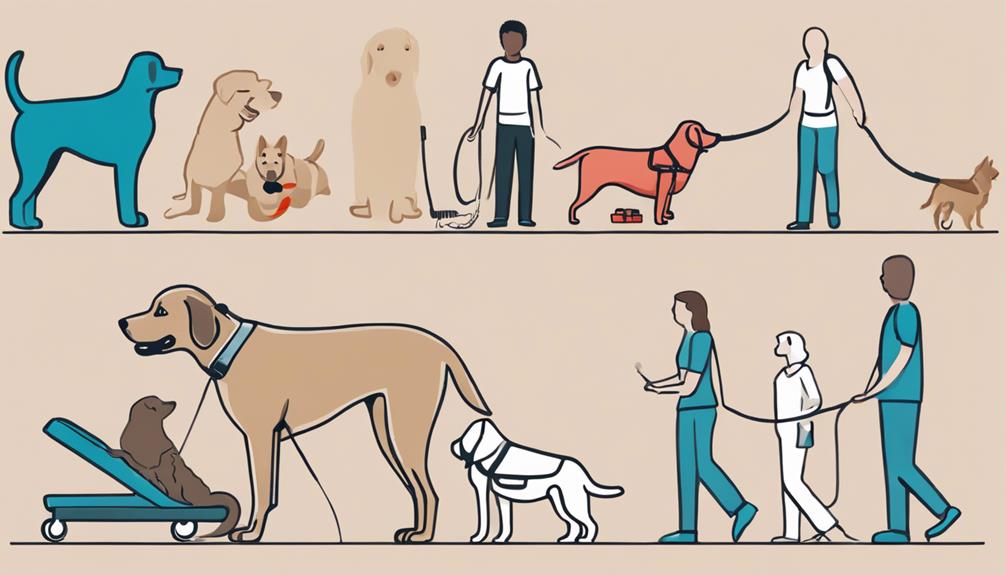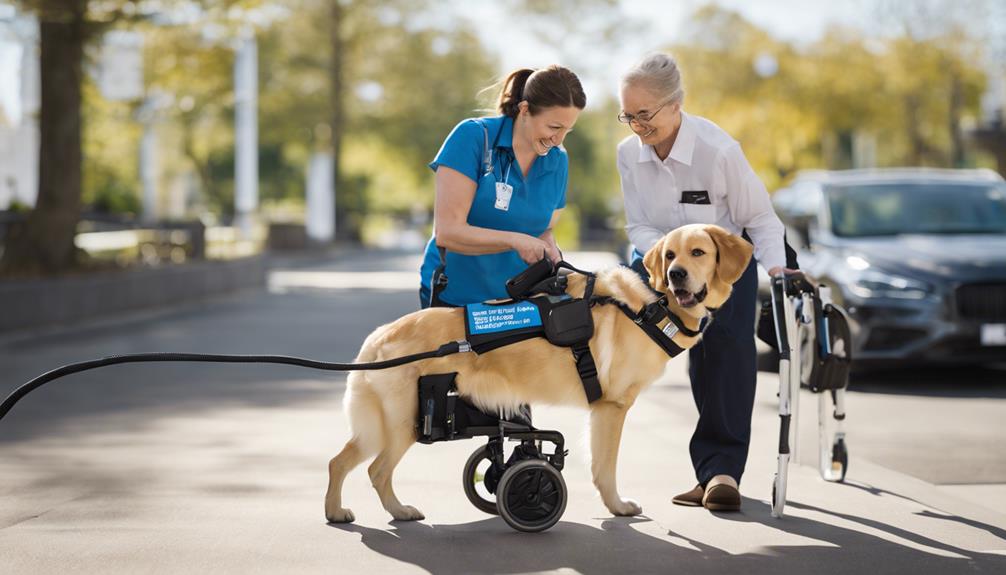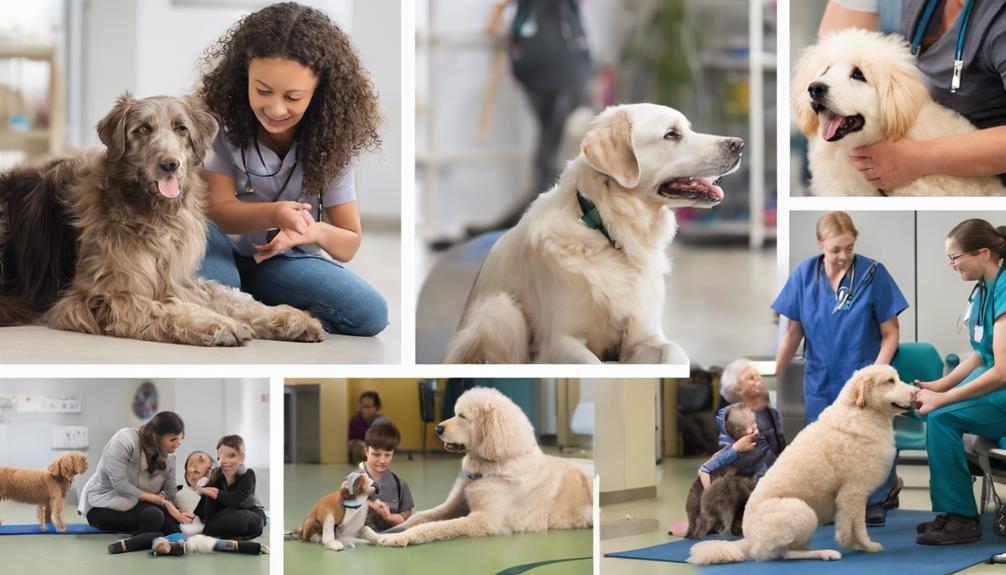11 Tips for Different Therapy Assistance Dog Types
Discover more about therapy assistance dogs with these 11 valuable tips: 1) Understand the specific role and training of each type of therapy dog. 2) Appreciate the impact of positive reinforcement techniques in their development. 3) Recognize the legal protections for emotional support dogs. 4) Learn about the rigorous certification process for therapy dogs. 5) Recognize the diverse benefits they offer, from lowering anxiety to improving mood. 6) Consider the specialized training required for psychiatric service dogs. 7) Appreciate how autism support dogs cater to individual needs. 8) Understand the crucial role seizure alert dogs play in health management. 9) Acknowledge the life-saving abilities of diabetic alert dogs. 10) Recognize the enhanced quality of life hearing dogs provide. 11) Explore the tailored tasks mobility assistance dogs perform to boost independence.
Service Dogs
When considering therapy assistance dogs, it's essential to understand the invaluable role that service dogs play in providing support and comfort to individuals in need. Service dogs are specially trained to assist people with disabilities, performing specific tasks to aid their handlers in their daily lives. These dogs undergo rigorous training techniques to ensure they can effectively support individuals with various needs.
Training techniques for service dogs are based on the specific requirements of their handlers. These techniques are designed to teach the dogs how to perform tasks such as guiding individuals who are visually impaired, alerting individuals with hearing impairments to sounds, providing stability and balance support, retrieving items, and even opening doors. The training process is intensive and focuses on reinforcing positive behaviors through rewards and repetition.
In addition to their training techniques, service dogs are protected by specific legal rights to ensure they can accompany their handlers in public places. The Americans with Disabilities Act (ADA) allows individuals with disabilities to be accompanied by their service dogs in all areas where the public is allowed, including restaurants, hotels, and shops. These legal rights are crucial in enabling individuals with disabilities to lead more independent and fulfilling lives with the assistance of their service dogs.
Emotional Support Dogs
Emotional support dogs play a vital role in providing comfort and companionship to individuals facing emotional or psychological challenges. These dogs aren't considered service animals under the Americans with Disabilities Act (ADA) but are protected under the Fair Housing Act (FHA) and the Air Carrier Access Act (ACAA).
When it comes to training techniques for emotional support dogs, they don't require the same level of training as service dogs. However, they should still undergo basic obedience training to ensure they can behave appropriately in public settings and provide the necessary support to their owners.
Legal rights pertaining to emotional support dogs allow individuals to live in housing that may otherwise have a no-pet policy and to travel with their emotional support animal in the cabin of an aircraft. It's important to note that emotional support animals don't have public access rights like service animals, and their access can be restricted to certain areas.
When training an emotional support dog, focus on behaviors that provide comfort and emotional support to their owners. This may include gentle nudging, leaning against their owner, or simply being a calming presence. Remember to always respect the rules and regulations regarding emotional support animals to ensure a positive and supportive relationship for both the individual and their canine companion.
Therapy Dogs
Therapy dogs provide invaluable support and comfort to individuals in various settings, such as hospitals, schools, and nursing homes. These specially trained canines play a crucial role in animal-assisted therapy, contributing to stress relief and emotional well-being.
Therapy dog training is a meticulous process that ensures these dogs are equipped to handle a range of situations. The certification process involves rigorous training to ensure the dogs are well-behaved, obedient, and sensitive to human emotions. They're taught to remain calm in various environments and to provide comfort without being intrusive.
When a therapy dog interacts with an individual, the benefits can be profound. The presence of a friendly and non-judgmental animal can help reduce anxiety, lower blood pressure, and release endorphins that improve mood. This therapeutic interaction is particularly beneficial for patients in hospitals, students in schools, and elderly residents in nursing homes.
If you're considering getting involved with therapy dogs, it's important to understand the commitment required. Handlers must be dedicated to maintaining the dog's training and well-being, as well as ensuring the safety and comfort of the individuals the dog interacts with. By following the proper training protocols and certification processes, you can help make a positive impact in the lives of many through the use of therapy dogs.
Psychiatric Service Dogs
Psychiatric Service Dogs play a vital role in providing assistance and support to individuals with mental health conditions through their specialized training and unique capabilities. These dogs undergo extensive training to perform specific tasks that help their handlers manage their psychiatric symptoms effectively. To become a psychiatric service dog, the training requirements are rigorous and focus on teaching the dog to recognize and respond to signs of distress or anxiety in their handler. This specialized training equips them to provide comfort, prevent panic attacks, interrupt harmful behaviors, and create a sense of safety for their handler in various situations.
The benefits of having a psychiatric service dog are manifold. These dogs offer emotional support, companionship, and a sense of security to individuals with mental health conditions. They can help reduce feelings of isolation, anxiety, and depression, ultimately improving their handler's overall quality of life. Additionally, psychiatric service dogs can assist in creating a routine, promoting physical activity, and enhancing social interactions, which are essential for mental well-being.
Public access rights for psychiatric service dogs are protected under the Americans with Disabilities Act (ADA). Despite this legal protection, there are myths and misconceptions surrounding these dogs, such as the belief that only visually impaired individuals can benefit from service dogs. It's crucial to understand and respect the role of psychiatric service dogs in supporting individuals with mental health conditions.
Autism Support Dogs
Autism Support Dogs play a crucial role in providing specialized assistance and support to individuals with autism spectrum disorder through their tailored training and unique abilities. These dogs are trained to fulfill various roles based on the specific needs of their handlers. Sensory stimulation dogs are adept at providing deep pressure therapy or tactile stimulation to help individuals with sensory sensitivities regulate their responses to external stimuli. Social interaction dogs are trained to assist in improving social skills by encouraging interaction with others and providing companionship.
Communication assistance dogs play a vital role in facilitating communication for nonverbal or partially verbal individuals with autism. These dogs can help in initiating interactions, fetching communication devices, or even alerting others in case of emergencies. Routine support dogs are trained to assist individuals in maintaining a structured daily routine, which can be highly beneficial for individuals with autism who thrive on predictability and consistency.
In addition to their specific roles, Autism Support Dogs also provide emotional support and companionship to their handlers, fostering a sense of security and comfort. These dogs are trained to respond calmly in various situations, helping to reduce anxiety and meltdowns. Overall, the specialized training and unique abilities of Autism Support Dogs make them invaluable companions for individuals with autism spectrum disorder.
Seizure Alert Dogs
Seizure Alert Dogs play a critical role in detecting and notifying individuals of imminent seizures through their trained ability to sense physiological changes before an episode occurs. These remarkable dogs undergo specialized training techniques to recognize subtle shifts in their owner's body chemistry or behavior that indicate an oncoming seizure. By alerting their owners or caregivers, Seizure Alert Dogs provide valuable time for preventative measures to be taken or for assistance to be summoned promptly.
In addition to their seizure response capabilities, these assistance dogs also offer a range of health benefits to those they assist. Their presence can reduce stress and anxiety levels in individuals with seizure disorders, promoting a sense of security and well-being. Furthermore, the constant companionship of a Seizure Alert Dog can help mitigate feelings of isolation that may arise from living with a medical condition.
For individuals requiring the support of a Seizure Alert Dog, public access is often a crucial consideration. These specially trained dogs are permitted in public spaces under the Americans with Disabilities Act (ADA), allowing their owners to lead more independent lives. This public access empowers individuals to engage in various activities with the reassurance of their loyal canine companion by their side.
Diabetic Alert Dogs

Diabetic Alert Dogs provide crucial support by detecting fluctuations in blood sugar levels to assist individuals with diabetes in managing their condition effectively. These specially trained dogs use their keen sense of smell to detect changes in their owner's blood sugar levels, alerting them or their caregivers before a critical situation arises.
Training techniques for Diabetic Alert Dogs are meticulous and specialized. The dogs are trained to recognize specific scents associated with changes in blood sugar levels, such as when glucose levels are too high or too low. Through positive reinforcement methods, these dogs learn to alert their owners by nudging them, fetching a glucose monitoring kit, or even activating an alarm system.
The health benefits of having a Diabetic Alert Dog are immense. By providing early warnings about blood sugar fluctuations, these dogs help prevent dangerous situations such as diabetic emergencies, seizures, or unconsciousness. Additionally, the constant companionship of these dogs can reduce stress and anxiety levels in individuals with diabetes, contributing to better overall health and well-being.
Hearing Dogs
Hearing Dogs play a vital role in assisting individuals with hearing impairments by alerting them to important sounds in their environment. These specially trained dogs undergo a rigorous training process to develop their communication skills and sound recognition abilities.
During the training process, Hearing Dogs are taught to differentiate between various sounds, such as doorbells, alarms, or someone calling their handler's name. They learn to make physical contact with their handler and lead them towards the source of the sound. This training is crucial to ensure that the dogs can effectively alert their handlers to important auditory cues in their surroundings.
In daily routines, Hearing Dogs become an integral part of their handler's life. They provide a sense of security by alerting them to sounds they may not hear on their own. This constant companionship helps individuals with hearing impairments navigate the world with more confidence and independence.
Sound recognition is a key skill that Hearing Dogs possess. They can detect a wide range of sounds and effectively communicate them to their handlers. By being attuned to their environment, these dogs enhance the quality of life for individuals with hearing impairments, allowing them to stay connected and safe in various situations.
Mobility Assistance Dogs

With a focus on enhancing independence and mobility for individuals with physical disabilities, Mobility Assistance Dogs play a crucial role in providing support and assistance in daily tasks. These specially trained dogs are invaluable partners for individuals with mobility challenges, aiding them in various ways to navigate the world more easily.
One key aspect of the work of Mobility Assistance Dogs is their ability to interact with assistive devices. These devices, such as wheelchairs, walkers, and canes, are essential tools for individuals with physical disabilities. Mobility Assistance Dogs are trained to work alongside these devices, helping their handlers by retrieving items, opening doors, or even pulling a wheelchair if needed. Their ability to seamlessly integrate with assistive technology makes them indispensable companions for those in need.
Training techniques for Mobility Assistance Dogs are tailored to meet the specific needs of each individual handler. These dogs undergo rigorous training to learn tasks that are customized to the handler's requirements. From turning on lights to picking up dropped items, these dogs are taught to perform a variety of tasks that can significantly improve the quality of life for their handlers. Through positive reinforcement and consistent practice, Mobility Assistance Dogs excel in providing the necessary support for individuals with physical disabilities.
Medical Alert Dogs
Medical Alert Dogs play a crucial role in detecting and responding to various medical conditions, providing invaluable support to individuals in need. These dogs undergo rigorous training processes to develop their ability to alert their handlers to specific health changes. The training involves teaching the dog to recognize the scent changes that occur in the body when a medical event is about to happen, such as a drop in blood sugar levels for diabetic alerts or changes in cortisol levels for those with Addison's disease.
The benefits of having a medical alert dog are significant. They can provide early warnings for conditions such as seizures, diabetes, allergies, and more, allowing their handlers to take necessary precautions or medications promptly. This early detection can be life-saving in many instances, giving individuals a sense of security and independence they may not have otherwise.
However, it's essential to understand the responsibilities and limitations that come with owning a medical alert dog. Handlers must ensure their dogs receive regular training updates to maintain their alertness levels. It's also crucial to remember that while these dogs are highly skilled, they aren't infallible. There may be instances where they miss an alert, emphasizing the importance of having other safety measures in place.
Facility Therapy Dogs

As we shift our focus to Facility Therapy Dogs, these specially trained canines play a vital role in providing emotional support and companionship to individuals in various facilities. Training requirements for facility therapy dogs are rigorous and specific to ensure they can excel in their roles. These dogs undergo obedience training, socialization exercises, and specialized tasks tailored to the needs of the facility they'll be working in.
The benefits of having facility therapy dogs are numerous. These furry companions can help reduce stress and anxiety levels among residents, patients, or clients in facilities such as hospitals, nursing homes, schools, and rehabilitation centers. Interactions with therapy dogs have been shown to improve mood, increase socialization among individuals, and even lower blood pressure and heart rate.
In facility settings, therapy dogs are often involved in structured activities planned by handlers or therapists. These activities can include one-on-one visits, group therapy sessions, or simply providing comfort by being present in common areas. Interactions between the facility therapy dogs and individuals are closely monitored to ensure safety and effectiveness in achieving therapeutic goals.
Frequently Asked Questions
Can Therapy Dogs Assist With Specific Phobias or Fears?
Yes, therapy dogs can assist with specific phobias or fears by providing anxiety relief and aiding in exposure therapy.
Through interaction with the dog, individuals can undergo desensitization to their triggers while learning coping mechanisms.
The presence of a therapy dog can offer comfort and support during these challenging situations, making it easier for individuals to confront and overcome their fears.
Do Seizure Alert Dogs Require Specialized Training for Different Types of Seizures?
Seizure alert dogs need specialized training to respond effectively to different types of seizures. Each seizure type may have unique triggers that the dog must learn to recognize.
Training requirements focus on teaching the dog to alert you before a seizure occurs, allowing you time to prepare or seek help.
These dogs play a crucial role in seizure response, requiring specific skills tailored to your individual seizure patterns.
How Do Diabetic Alert Dogs Differentiate Between High and Low Blood Sugar Levels?
To distinguish between high and low blood sugar levels, diabetic alert dogs are trained using specific methods. They learn to detect the scent changes associated with each condition and provide alert signals accordingly. This training ensures their medical accuracy and real-time responses.
Can Hearing Dogs Be Trained to Recognize Specific Sounds or Alarms?
Hearing dogs can indeed be trained to recognize specific sounds or alarms through sound recognition training techniques. By associating different sounds with specific behaviors or actions, these dogs learn to respond to alarms effectively.
Through consistent reinforcement and positive reinforcement, hearing dogs can exhibit reliable alarm response and behavior cues. This specialized training helps hearing dogs assist individuals with hearing impairments by alerting them to important sounds in their environment.
What Types of Tasks Can Mobility Assistance Dogs Help With in Daily Life?
Mobility assistance dogs can aid you in daily tasks like retrieving dropped items, opening doors, or even pulling a wheelchair. These tasks can greatly enhance your independence and quality of life.
Conclusion
In conclusion, understanding the various types of therapy assistance dogs and their specific roles can greatly benefit those in need of their support.
From service dogs to medical alert dogs, each type plays a crucial role in providing assistance and comfort to individuals with different needs.
By recognizing the unique abilities and training of these dogs, individuals can make informed decisions when seeking therapy assistance for themselves or loved ones.
It's important to appreciate the dedication and impact these dogs have on improving the quality of life for many individuals.
